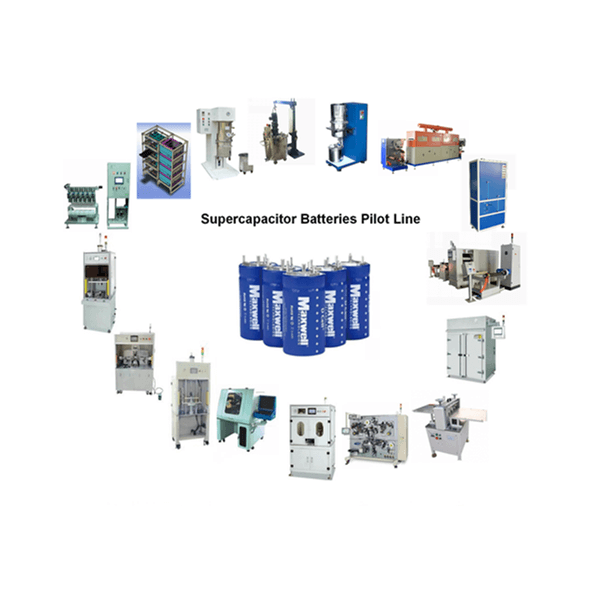- E-Mail : David@tmaxcn.com
- E-Mail : Davidtmaxcn@gmail.com
- : No. 39, Xinchang Road, Xinyang, Haicang Dist., Xiamen, Fujian, China (Mainland)
Blog
Supercapacitor Pilot Equipment
Supercapacitor pilot equipment refers to specialized machinery and systems designed for the intermediate stage between laboratoryscale prototyping and fullscale industrial production. This equipment is used to validate processes, refine manufacturing techniques, and optimize performance before scaling up to mass production. By enabling controlled experimentation and iterative improvements, supercapacitor pilot equipment plays a critical role in bridging the gap between research and commercialization.
In this article, we will explore the structure, functionality, advantages, challenges, and innovations associated with supercapacitor pilot equipment.
●What Is Supercapacitor Pilot Equipment?
Supercapacitor pilot equipment consists of scaleddown versions of industrial production lines that simulate the key stages of supercapacitor fabrication. These systems are designed to test new materials, chemistries, and process parameters in a controlled environment while producing small batches of supercapacitors. The goal is to ensure that all aspects of the manufacturing process are optimized before transitioning to largescale production.
The primary purpose of supercapacitor pilot equipment is to:
1. Validate new technologies and materials.
2. Optimize process parameters for scalability.
3. Identify potential bottlenecks or issues in the production workflow.
4. Generate samples for testing and evaluation by customers or partners.
●Key Components of Supercapacitor Pilot Equipment
A typical supercapacitor pilot setup includes the following modules:
1. Material Preparation Module
Prepares slurries by mixing active materials (e.g., activated carbon, graphene), binders, conductive additives, and solvents.
Ensures uniformity and consistency in material preparation.
2. Electrode Coating and Drying Module
Applies slurries onto current collector foils (e.g., aluminum or nickel) using scalable coating techniques such as slot die coating or doctor blade coating.
Dries the coated electrodes under controlled temperature and humidity conditions.
3. Cutting and Tab Welding Module
Cuts dried electrodes into precise dimensions using laser cutting or mechanical dies.
Attaches current collector tabs via resistance welding, ultrasonic welding, or laser welding.
4. Cell Assembly Module
Stacks or winds electrodes with separators to form the core assembly.
Ensures proper alignment and spacing between layers.
5. Housing Insertion and Sealing Module
Places the assembled core into prefabricated housings.
Seals the housing using heat sealing, laser welding, or ultrasonic welding.
6. Electrolyte Injection Module
Injects liquid electrolytes into the sealed housing under vacuum or pressure conditions.
Avoids air bubbles and ensures complete wetting of electrodes.
7. Formation and Activation Module
Charges and discharges the cells under controlled conditions to activate their electrochemical properties.
Enhances capacitance and reduces internal resistance.
8. Testing and Quality Control Module
Conducts rigorous tests to verify capacitance, internal resistance, leakage current, safety, and durability.
Identifies defective units and provides feedback for process improvement.
9. Data Collection and Analysis System
Monitors and records data from each step of the process for analysis and optimization.
Uses advanced software tools for realtime monitoring and predictive analytics.
●Processes Performed by Supercapacitor Pilot Equipment
The pilot equipment performs the following key processes:
1. Material Testing: Evaluates the performance of new materials and formulations.
2. Process Optimization: Refines coating, drying, stacking, and sealing processes for scalability.
3. Prototype Fabrication: Produces small batches of supercapacitors for testing and validation.
4. Quality Assurance: Ensures consistent performance across batches.
5. Data Analysis: Collects and analyzes data to identify areas for improvement.
●Advantages of Supercapacitor Pilot Equipment
1. Process Validation:
Validates new materials, chemistries, and manufacturing techniques before fullscale production.
2. Cost Efficiency:
Reduces the risk and cost of scaling up unproven processes by identifying issues early.
3. Scalability Testing:
Simulates industrialscale production to ensure processes can be scaled effectively.
4. Customization:
Allows for rapid iteration and customization of designs and materials.
5. DataDriven Insights:
Provides valuable data for process optimization and continuous improvement.
6. Risk Mitigation:
Minimizes risks associated with transitioning from labscale prototypes to industrialscale production.
●Challenges in Supercapacitor Pilot Equipment
Despite its benefits, supercapacitor pilot equipment faces certain challenges:
1. Complex Integration:
Coordinating multiple modules and processes requires advanced engineering and software control systems.
2. Material Handling:
Handling delicate materials like thin electrodes and porous separators without causing damage is challenging.
3. Sealing Integrity:
Ensuring reliable seals that withstand repeated chargedischarge cycles and environmental conditions is critical but difficult.
4. High Initial Costs:
Advanced automation and precision machinery come with significant upfront investment.
5. Adaptability to New Technologies:
Rapid advancements in supercapacitor materials and designs require frequent upgrades to keep equipment uptodate.
●Innovations in Supercapacitor Pilot Equipment
To address these challenges and enhance productivity, manufacturers are incorporating cuttingedge technologies:
1. Advanced Sensors and Vision Systems:
Realtime monitoring of component alignment, sealing quality, and overall assembly ensures consistent output.
2. AI and Machine Learning:
Predictive analytics optimize machine performance, detect anomalies, and improve yield rates.
3. Modular Design:
Flexible systems allow for easy reconfiguration to test new materials, chemistries, and cell designs.
4. Sustainability Features:
Ecofriendly practices minimize waste and energy consumption during the fabrication process.
5. SolidState Adaptation:
Future equipment will be designed to handle solidstate electrolytes, enabling safer and more efficient nextgeneration supercapacitors.
6. Collaborative Robotics:
Humanmachine collaboration enhances flexibility and adaptability in production processes.
●Applications of Supercapacitor Pilot Equipment
Supercapacitor pilot equipment is used in a wide range of industries, including:
1. Research Institutions:
Validates new materials and chemistries developed in labs.
2. Manufacturers:
Tests and refines production processes before scaling up.
3. Automotive Industry:
Develops highpower supercapacitors for hybrid and electric vehicles.
4. Renewable Energy:
Creates durable supercapacitors for energy storage applications in solar panels, wind turbines, and grid stabilization systems.
5. Consumer Electronics:
Produces compact supercapacitors for smartphones, wearables, and portable devices.
●The Future of Supercapacitor Pilot Equipment
As the demand for advanced energy storage solutions grows, supercapacitor pilot equipment will continue to evolve. Key trends shaping the future include:
1. Increased Automation:
Fully autonomous systems will further boost production speeds and reduce costs.
2. Customization Options:
Modular designs will enable manufacturers to tailor equipment for specific cell types and chemistries.
3. Focus on Sustainability:
Ecofriendly practices and recycling capabilities will become integral parts of future equipment.
4. Integration with Emerging Technologies:
Solidstate supercapacitors, flexible electronics, and autonomous systems will drive new innovations in pilot processes.
5. Smart Manufacturing:
IoTenabled equipment will leverage big data and AI to optimize production, reduce waste, and enhance efficiency.
●Conclusion
Supercapacitor pilot equipment is essential for advancing the field of energy storage by enabling the transition from laboratoryscale prototypes to industrialscale production. It provides precision, consistency, and flexibility while reducing risks and costs associated with scaling up new technologies.
What excites you most about the role of pilot equipment in supercapacitor development? Share your thoughts below! Together, let’s explore how this equipment can drive innovation and sustainability in the energy storage sector.

June 20,2025.
Xiamen Tmax Battery Equipments Limited was set up as a manufacturer in 1995, dealing with lithium battery equipments, technology, etc. We have total manufacturing facilities of around 200000 square foot and more than 230 staff. Owning a group of experie-nced engineers and staffs, we can bring you not only reliable products and technology, but also excellent services and real value you will expect and enjoy.
Supercapacitor Pilot Equipment: Bridging LabScale Prototyping and Industrial Production
Supercapacitor pilot equipment refers to specialized machinery and systems designed for the intermediate stage between laboratoryscale prototyping and fullscale industrial production. This equipment is used to validate processes, refine manufacturing techniques, and optimize performance before scaling up to mass production. By enabling controlled experimentation and iterative improvements, supercapacitor pilot equipment plays a critical role in bridging the gap between research and commercialization.
In this article, we will explore the structure, functionality, advantages, challenges, and innovations associated with supercapacitor pilot equipment.
●What Is Supercapacitor Pilot Equipment?
Supercapacitor pilot equipment consists of scaleddown versions of industrial production lines that simulate the key stages of supercapacitor fabrication. These systems are designed to test new materials, chemistries, and process parameters in a controlled environment while producing small batches of supercapacitors. The goal is to ensure that all aspects of the manufacturing process are optimized before transitioning to largescale production.
The primary purpose of supercapacitor pilot equipment is to:
1. Validate new technologies and materials.
2. Optimize process parameters for scalability.
3. Identify potential bottlenecks or issues in the production workflow.
4. Generate samples for testing and evaluation by customers or partners.
●Key Components of Supercapacitor Pilot Equipment
A typical supercapacitor pilot setup includes the following modules:
1. Material Preparation Module
Prepares slurries by mixing active materials (e.g., activated carbon, graphene), binders, conductive additives, and solvents.
Ensures uniformity and consistency in material preparation.
2. Electrode Coating and Drying Module
Applies slurries onto current collector foils (e.g., aluminum or nickel) using scalable coating techniques such as slot die coating or doctor blade coating.
Dries the coated electrodes under controlled temperature and humidity conditions.
3. Cutting and Tab Welding Module
Cuts dried electrodes into precise dimensions using laser cutting or mechanical dies.
Attaches current collector tabs via resistance welding, ultrasonic welding, or laser welding.
4. Cell Assembly Module
Stacks or winds electrodes with separators to form the core assembly.
Ensures proper alignment and spacing between layers.
5. Housing Insertion and Sealing Module
Places the assembled core into prefabricated housings.
Seals the housing using heat sealing, laser welding, or ultrasonic welding.
6. Electrolyte Injection Module
Injects liquid electrolytes into the sealed housing under vacuum or pressure conditions.
Avoids air bubbles and ensures complete wetting of electrodes.
7. Formation and Activation Module
Charges and discharges the cells under controlled conditions to activate their electrochemical properties.
Enhances capacitance and reduces internal resistance.
8. Testing and Quality Control Module
Conducts rigorous tests to verify capacitance, internal resistance, leakage current, safety, and durability.
Identifies defective units and provides feedback for process improvement.
9. Data Collection and Analysis System
Monitors and records data from each step of the process for analysis and optimization.
Uses advanced software tools for realtime monitoring and predictive analytics.
●Processes Performed by Supercapacitor Pilot Equipment
The pilot equipment performs the following key processes:
1. Material Testing: Evaluates the performance of new materials and formulations.
2. Process Optimization: Refines coating, drying, stacking, and sealing processes for scalability.
3. Prototype Fabrication: Produces small batches of supercapacitors for testing and validation.
4. Quality Assurance: Ensures consistent performance across batches.
5. Data Analysis: Collects and analyzes data to identify areas for improvement.
●Advantages of Supercapacitor Pilot Equipment
1. Process Validation:
Validates new materials, chemistries, and manufacturing techniques before fullscale production.
2. Cost Efficiency:
Reduces the risk and cost of scaling up unproven processes by identifying issues early.
3. Scalability Testing:
Simulates industrialscale production to ensure processes can be scaled effectively.
4. Customization:
Allows for rapid iteration and customization of designs and materials.
5. DataDriven Insights:
Provides valuable data for process optimization and continuous improvement.
6. Risk Mitigation:
Minimizes risks associated with transitioning from labscale prototypes to industrialscale production.
Supercapacitor Pilot Line Equipment
●Challenges in Supercapacitor Pilot Equipment
Despite its benefits, supercapacitor pilot equipment faces certain challenges:
1. Complex Integration:
Coordinating multiple modules and processes requires advanced engineering and software control systems.
2. Material Handling:
Handling delicate materials like thin electrodes and porous separators without causing damage is challenging.
3. Sealing Integrity:
Ensuring reliable seals that withstand repeated chargedischarge cycles and environmental conditions is critical but difficult.
4. High Initial Costs:
Advanced automation and precision machinery come with significant upfront investment.
5. Adaptability to New Technologies:
Rapid advancements in supercapacitor materials and designs require frequent upgrades to keep equipment uptodate.
●Innovations in Supercapacitor Pilot Equipment
To address these challenges and enhance productivity, manufacturers are incorporating cuttingedge technologies:
1. Advanced Sensors and Vision Systems:
Realtime monitoring of component alignment, sealing quality, and overall assembly ensures consistent output.
2. AI and Machine Learning:
Predictive analytics optimize machine performance, detect anomalies, and improve yield rates.
3. Modular Design:
Flexible systems allow for easy reconfiguration to test new materials, chemistries, and cell designs.
4. Sustainability Features:
Ecofriendly practices minimize waste and energy consumption during the fabrication process.
5. SolidState Adaptation:
Future equipment will be designed to handle solidstate electrolytes, enabling safer and more efficient nextgeneration supercapacitors.
6. Collaborative Robotics:
Humanmachine collaboration enhances flexibility and adaptability in production processes.
●Applications of Supercapacitor Pilot Equipment
Supercapacitor pilot equipment is used in a wide range of industries, including:
1. Research Institutions:
Validates new materials and chemistries developed in labs.
2. Manufacturers:
Tests and refines production processes before scaling up.
3. Automotive Industry:
Develops highpower supercapacitors for hybrid and electric vehicles.
4. Renewable Energy:
Creates durable supercapacitors for energy storage applications in solar panels, wind turbines, and grid stabilization systems.
5. Consumer Electronics:
Produces compact supercapacitors for smartphones, wearables, and portable devices.
●The Future of Supercapacitor Pilot Equipment
As the demand for advanced energy storage solutions grows, supercapacitor pilot equipment will continue to evolve. Key trends shaping the future include:
1. Increased Automation:
Fully autonomous systems will further boost production speeds and reduce costs.
2. Customization Options:
Modular designs will enable manufacturers to tailor equipment for specific cell types and chemistries.
3. Focus on Sustainability:
Ecofriendly practices and recycling capabilities will become integral parts of future equipment.
4. Integration with Emerging Technologies:
Solidstate supercapacitors, flexible electronics, and autonomous systems will drive new innovations in pilot processes.
5. Smart Manufacturing:
IoTenabled equipment will leverage big data and AI to optimize production, reduce waste, and enhance efficiency.
●Conclusion
Supercapacitor pilot equipment is essential for advancing the field of energy storage by enabling the transition from laboratoryscale prototypes to industrialscale production. It provides precision, consistency, and flexibility while reducing risks and costs associated with scaling up new technologies.
What excites you most about the role of pilot equipment in supercapacitor development? Share your thoughts below! Together, let’s explore how this equipment can drive innovation and sustainability in the energy storage sector.

 ru
ru English
English










 +86 13174506016
+86 13174506016 David@tmaxcn.com
David@tmaxcn.com +86 18659217588
+86 18659217588
